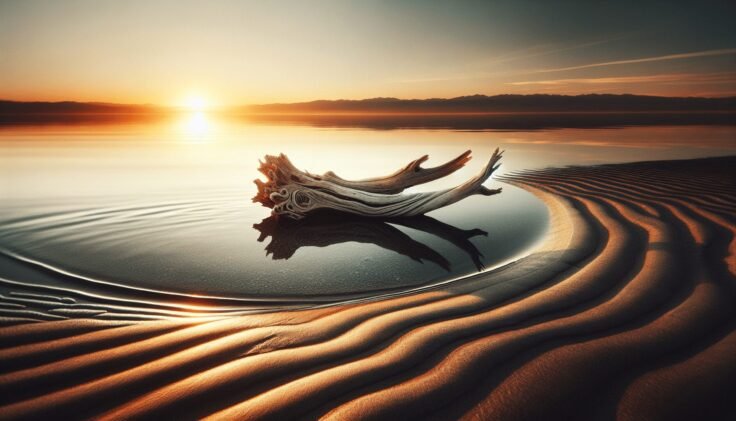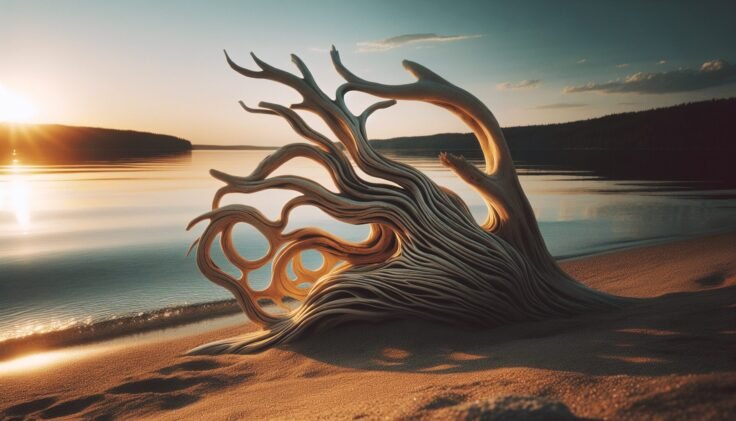Have you ever wandered along a beach and stumbled upon pieces of beautifully weathered wood that seem to tell a story all their own? These unique bits of nature, known as driftwood, have fascinated beachgoers for centuries. Their intricate textures and varying shapes are both mysterious and enchanting, sparking curiosity about where they come from and how they find their way onto sandy shores.
What is Driftwood?
Driftwood is essentially wood that has been washed onto the shore by the action of winds, tides, or waves. It often starts its journey from trees near a river or a coastline, uprooted by natural forces such as storms or erosion. This wood then travels along waterways, perhaps for months or even years, before landing on beaches around the world.
The Unique Characteristics of Driftwood
The process of weathering gives driftwood its distinctive features. As it is carried by water, it is exposed to elements like salt, moisture, and sunlight, which strip away bark and smooth its edges. This natural process, often spanning months, results in the silvery-gray color and sculptural forms that many find so appealing. Because no two pieces of driftwood are alike, each one has its own character, making it a prized find for beachcombers and artists alike.
The Journey of Driftwood
Understanding how driftwood makes its journey to the seaside involves appreciating the intricate dynamics of nature. The path it takes can be long and winding, shaped by various environmental factors that dictate its final destination.
Origins of Driftwood
Driftwood typically originates from trees growing near rivers, lakes, or oceans. When these trees are felled by natural events like hurricanes, floods, or landslides, their branches and trunks can be carried away by strong currents. Driftwood might also originate from logging activities where logs are transported via rivers, with some inevitably detaching and starting their voyage to the sea.
The Voyage Across Water
Once in the water, the journey of driftwood is dictated by currents, tides, and winds. It may travel hundreds or even thousands of kilometers before reaching a beach. Throughout this voyage, driftwood becomes exposed to seawater, insects, and the sun, gradually losing its bark and taking on the smooth, unique forms favored by nature.
Arrival at the Beach
The final stop for driftwood is often a sandy beach, where it is left by the retreating tides. Not all driftwood ends up on beaches, as some continue to float or break down in the ocean. The pieces that do land on shores become part of the landscape, adding to the beauty and diversity of the coastal environment.

Ecological Importance of Driftwood
Beyond its aesthetic value, driftwood plays a critical role in coastal ecosystems. It provides habitat, influences geomorphology, and contributes to nutrient cycling, underscoring its environmental significance.
Driftwood as Habitat
For many organisms, driftwood is more than just a piece of wood—it’s a habitat. Microorganisms, insects, and small crustaceans often find refuge within its crevices. It serves as a substrate for barnacles and algae, which become food sources for various marine life. Birds and small mammals might use larger pieces as nesting sites, taking advantage of the shelter and stability provided by driftwood.
Influence on Coastal Geomorphology
Driftwood can affect the shape and structure of beaches. Large pieces of driftwood stabilize sand dunes by acting as natural windbreaks. This stabilization helps prevent erosion and maintain the integrity of the coastal landscape. Additionally, piles of driftwood can alter the flow of water along the shore, creating small estuaries and marshlands that further enhance biodiversity.
Nutrient Cycling
As driftwood decomposes, it releases nutrients back into the surrounding environment. These nutrients nourish plant life in coastal areas, supporting a rich web of biodiversity. This process makes driftwood an invaluable component of coastal health, contributing to the productivity and resilience of seaside ecosystems.
Artistic and Cultural Connections
For centuries, people have been drawn to the artistic and cultural significance of driftwood. Its unique shapes and textures offer inspiration to artists and artisans, while its presence in folklore and tradition adds depth to human interactions with nature.
Driftwood in Art and Design
Artists often see driftwood as a canvas shaped by time and the elements. Its unpredictable forms lend themselves to creativity and expression. Driftwood is frequently used in sculptures, furniture, and decorative items, bridging the gap between natural beauty and artistic vision. The organic lines and textures found in driftwood make it a popular choice for those looking to bring a piece of nature into their homes or galleries.
Driftwood in Cultural Traditions
Many coastal cultures incorporate driftwood into their traditions and folklore. For some, it is seen as a symbol of transformation and resilience, reflecting the natural journey it undergoes. In others, it serves practical purposes, such as building structures or tools. Stories and legends about driftwood can be found across the world, illustrating the deep connection between humans and this natural phenomenon.
Collecting and Using Driftwood
The allure of driftwood often tempts beachgoers to collect these treasures, but it’s important to do so responsibly. Understanding local regulations and considering environmental impacts are key to sustainable driftwood collection.
Guidelines for Collecting Driftwood
Before you start collecting driftwood, research any local rules or restrictions. Some areas have regulations to protect coastal ecosystems, limiting the collection of natural materials like driftwood. If collecting is permitted, be mindful of taking only what’s needed and avoid disturbing wildlife.
| Guideline | Description |
|---|---|
| Research Local Rules | Check local regulations before collecting driftwood. |
| Minimal Impact | Take only what you need and avoid disturbing habitats. |
| Leave Some Behind | Leave pieces that provide habitat or are part of the landscape. |
Creative Uses for Driftwood
Driftwood’s versatility offers countless creative possibilities. You can use it to make rustic furniture, unique art pieces, or even garden ornaments. Its organic forms make for stunning jewelry or home decor items, bringing a touch of nature indoors. Remember to clean and treat the wood appropriately to preserve its beauty and ensure longevity.
The Mystical Appeal of Driftwood
What is it about driftwood that captures our imagination? Perhaps it’s the way its foreign shapes evoke thoughts of distant lands and mysterious voyages. Each piece tells a silent story of a journey undertaken, inviting us to ponder the passage of time and the power of nature.
The Storytelling Aspect of Driftwood
Every piece of driftwood is a storyteller, whispering tales of its travels through time and water. Imagining the journey it has taken, the places it might have visited, and the forces that have shaped it, glorifies the raw power and capriciousness of nature. This allure hooks us, transforming a simple piece of wood into a symbol of exploration and discovery.
Driftwood and Mindfulness
For many, collecting and working with driftwood is a mindful activity. Walking along the beach in search of the perfect piece offers a moment of calm and reflection. The act of crafting with driftwood further promotes mindfulness, as it requires attention to detail and an appreciation for imperfections. This connection to nature and creativity can be a soothing and grounding experience.
Protecting Driftwood Resources
As with many natural wonders, it is essential to protect and preserve driftwood resources for future generations. Responsible interaction with this natural treasure ensures coastal ecosystems remain healthy and vibrant.
Promoting Sustainable Practices
Sustainability involves being conscious of how our actions affect the environment and taking steps to minimize negative impacts. When interacting with driftwood, consider the role it plays in its ecosystem. Avoid removing pieces that are crucial to habitat stability or taking more than necessary.
Educating Others About Driftwood
Spreading awareness about the importance and ecological function of driftwood can further promote its conservation. Sharing knowledge with others, whether through educational programs or informal conversations, helps create a collective appreciation for driftwood and the environmental roles it plays.
Conclusion
Driftwood at the beach is more than just a visual delight; it is a symbol of nature’s ability to shape and transform. From its journey across waterways to its ecological significance, driftwood captivates us with its beauty and mystery. As you wander along the beach, take a moment to appreciate the stories each piece tells and reflect on your role in safeguarding this natural wonder. By understanding and respecting driftwood, you contribute to preserving the enchanting landscapes where these unique pieces reside.

